The word 'conifer' is an abbreviation of coniferous, which simply means cone-bearing - and most people recognise conifers by the presence of cones (though of course, this is nature, so there are exceptions!). Conifers emerged on planet Earth about 300 million years ago and came to dominate the landscape (along with ferns and horsetails) before grasses and other true flowering plants appeared. When identifying conifers, most can immediately be split into one of two groups - those with elongate, linear leaves and those with scale-like, often overlapping leaves. In many species, the seed-bearing cones or fruits take a full year or more to develop and many last for a number of years on the ground beneath the tree once they have fallen, so they can often be a useful aid to identification.
The main purpose of this page is to attempt to break this group up into bite-sized chunks, so that the pages you are led to do not get too big by containing a large number of species. At worst, if you follow a link from here and do not see your plant, return to this page and try another link.
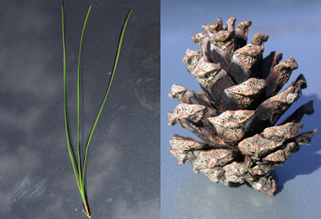 |
Pines
The pines are mostly full-sized trees, mostly with single trunks but sometimes branching from low down and multistemmed. These trees are readily told by their long to very long, needle-like leaves which are borne in clusters that are joined at the base. Most of our pines have leaves in clusters of two or three, but some species have leaves in bundles of fives. The bark is variable but usually deeply fissured on older trees and with a scaly appearance, with the bark coming away in thin flakes. Seed-bearing cones soon become hard and woody and may last for several years on the tree. They drop whole and are easily found beneath the trees. |
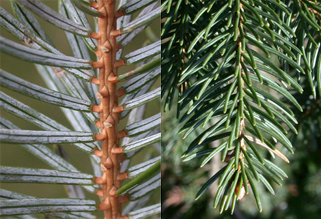 |
Spruces
Tall, stately trees with regular branching in tiers. The leaves are reduced to linear, pointed needles, which are carried singly on the stem, not in bundles. Look closely at where the needle attaches and you will find that each needle sits on a small, peg-like protuberance on the stem; this protuberance is left behind when the needle eventually drops (or is removed), giving the stem a very bumpy or prickly look (compare with silver firs, below). Cones are variable but, on almost all species, they tend to hang below the branch and do not stand upright. |
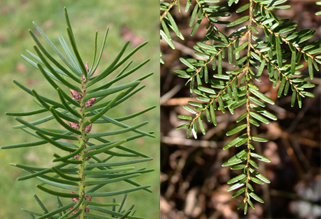 |
Spruce Allies
Tall, stately trees with a somewhat irregular look, the branches typically being pendent or almost weeping in appearance. The leaves are reduced to linear, pointed needles, which are carried singly on the stem, not in bundles. Look closely at where the needle attaches and you will find that each needle sits on a small, peg-like protuberance on the stem; this protuberance is left behind when the needle eventually drops (or is removed), giving the young stem a bumpy or prickly look (compare with silver firs, below). Cones are variable, but they tend to hang below the branch and do not stand upright. |
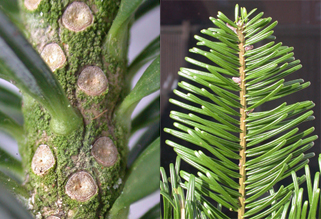 |
Silver Firs
Tall, stately trees with regular branching in tiers. The leaves are reduced to linear, pointed needles, which are carried singly on the stem, not in bundles. Look closely at where the needle attaches and you will find that each needle has a swollen base, like a small sucker cup. When the needle eventually drops (or is removed), a round depression is left on the stem, leaving the stem looking smooth but with a series of rounded marks (compare with spruces, above). Cones are generally cylindrical and are carried upright like candles on the upper branches of the tree; they are often bluish or purple before they ripen. Cones differ from most other conifers (except cedars) in that they break up on the tree. This means that you will rarely find a cone beneath the tree, but the ground will be littered with the fallen scales of the cones. |
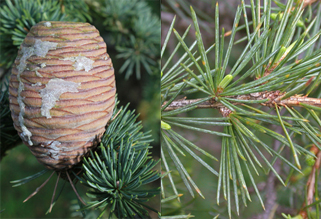 |
Cedars
These are large, dark and imposing trees that spread widely as they mature. The leaves are reduced to narrow, linear needles, joined together in clusters at the base, with usually more than five per bundle. Note that vigorous young shoots during the growing season also have longer needles carried singly and scattered along the stems between the clusters. Cones are large and chunky, with many, narrow, greatly overlapping and densely packed scales. Cones are often carried on lower branches, but break up on the tree (like those of silver firs) so whole cones are seldom found on the ground. Bark dark, craggy and cracked. |
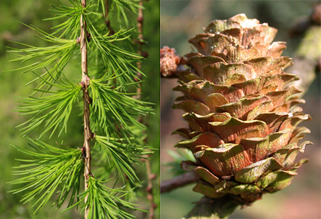 |
Larches
Narrow trees with straight trunks and very slender, hanging branches. The leaves are reduced to narrow, linear needles, carried in bundles of more than five. Larches are deciduous trees, losing their leaves each autumn; thus, the branches carry needles only on the current season's growth. Branches are thin and flexible and hanging gracefully, with the needles emerging from lumpy nodes or spurs on the branches. In their leaves, larches can look quite like cedars, but they can be told by their cones which are small and relatively soft, drop entirely (not breaking up on the tree) and are carried in large quantity along the branches. |
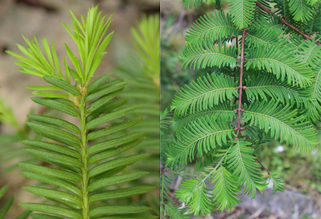 |
Flat-needled Conifers
This is something of a hotch potch group of trees, some tall and narrow, others shorter and more spreading. It also includes both evergreen and deciduous species, but these species all have needle-like leaves that are carried singly - not in bundles - but are broader than those of the spruces or silver firs. In some species, the plants form short side growths with the leaves arranged neatly in parallel rows, giving the impression of compound leaves. |
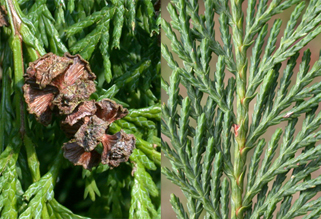 |
Cypresses & Allies
Cypress trees have very unusual leaves, which are reduced greatly to resemble scale-like structures, overlapping each other and usually arranged in opposite pairs. The leaves overlap along the young stems to form either cord-like growths or, more often, flattened, many-branched sprays of vegetation. The trees themselves are usually columnar in shape and densely branched, often being used to form impenetrable hedges and barriers. The seed-bearing cones are typically small and globular and carried in branched clusters, but may also be cylindrical in shape. |
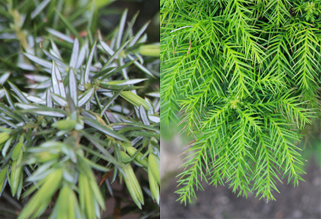 |
Junipers & Allies
The junipers have two types of foliage, one of which resembles the cypresses in the short, scale-like leaves that strongly overlap each other. However, this group of junipers differs in having more sharply pointed leaves that are somewhat midway between needles and scales. The leaves can be painfully sharp if touched, while plants may be anything from creeping ground cover to upright, shrubby trees. True junipers have seed-bearing fruits that become fleshy and berry-like when ripe (changing from green to bluish or shiny brown when ripe), while other, similarly-leaved species may have dry, wooden cones. |
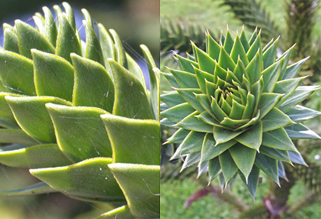 |
Araucarias
Strange, columnar trees with long, sinuous branches that are covered in extremely sharp-tipped, broadly scale-like and overlapping leaves that clothe the branches for many years before eventually falling off the older stems. Male and female cones are carried in separate trees but both have the same prickly nature as the leaves and are carried high up on older, larger trees. The bark is grey with many horizontal ridges. |